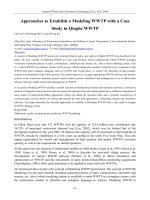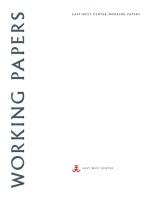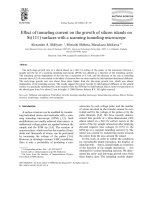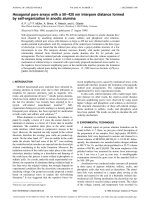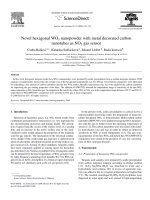- Trang chủ >>
- Khoa Học Tự Nhiên >>
- Vật lý
hexagonal pore arrays with a 50 – 420 nm interpore distance formed
Bạn đang xem bản rút gọn của tài liệu. Xem và tải ngay bản đầy đủ của tài liệu tại đây (883.65 KB, 4 trang )
Hexagonal pore arrays with a 50–420 nm interpore distance formed
by self-organization in anodic alumina
A. P. Li,
a)
F. Mu
¨
ller, A. Birner, K. Nielsch, and U. Go
¨
sele
Max-Planck-Institute of Microstructure Physics, Weinberg 2, 06120 Halle, Germany
͑Received 6 May 1998; accepted for publication 17 August 1998͒
Self-organized hexagonal pore arrays with a 50–420 nm interpore distance in anodic alumina have
been obtained by anodizing aluminum in oxalic, sulfuric, and phosphoric acid solutions.
Hexagonally ordered pore arrays with distances as large as 420 nm were obtained under a constant
anodic potential in phosphoric acid. By comparison of the ordered pore formation in the three types
of electrolyte, it was found that the ordered pore arrays show a polycrystalline structure of a few
micrometers in size. The interpore distance increases linearly with anodic potential, and the
relationship obtained from disordered porous anodic alumina also fits for periodic pore
arrangements. The best ordered periodic arrangements are observed when the volume expansion of
the aluminum during oxidation is about 1.4 which is independent of the electrolyte. The formation
mechanism of ordered arrays is consistent with a previously proposed mechanical stress model, i.e.,
the repulsive forces between neighboring pores at the metal/oxide interface promote the formation
of hexagonally ordered pores during the oxidation process. © 1998 American Institute of Physics.
͓S0021-8979͑98͒00423-X͔
I. INTRODUCTION
Ordered nanochannel-array materials have attracted in-
creasing attention in recent years due to their utilization as
templates for nanosize structures, such as magnetic, elec-
tronic, and optoelectronic devices.
1,2
Anodic porous alumina,
which has been studied in detail in various electrolytes over
the last five decades,
3
has recently been reported to be a
typical self-ordered nanochannel material.
4,5
Self-
organization during pore growth, leading to a densely packed
hexagonal pore structure, has been reported for anodization
in both oxalic and sulfuric acid solutions.
4–6
When aluminum is oxidized to alumina, the volume ex-
pands by roughly a factor of 2 since the atomic density of
aluminum in alumina is a factor of 2 lower than in metallic
aluminum. The oxidation takes place at the entire metal/
oxide interface, which leads to compressive stresses in the
layer. However, the material can only expand in the vertical
direction, therefore the existing pore walls are pushed up-
wards. On the other hand, Al
3ϩ
ions are mobile in the oxide
under the electric field and some of the Al
3ϩ
ions reaching
the oxide/electrolyte interface are injected into the electrolyte
without contributing to the oxide formation. Moreover, the
hydration reaction of the oxide layer takes place at the oxide/
electrolyte interface leading to a dissolution and thinning of
the oxide layer; this process is more evident in phosphoric or
sulfuric acids. As a result, under the usual experimental con-
ditions, the expansion of aluminum during oxidation leads to
less than twice the original volume, but strongly depends on
experimental conditions like the electrolyte concentration or
anodizing voltage. Our group has recently proposed a model
based on mechanical stress to explain this self-ordering
formation.
6
It was suggested that the repulsive forces be-
tween neighboring pores caused by mechanical stress at the
metal/oxide interface promote the formation of hexagonally
ordered pore arrangements. The explanation should be
supplemented by more experimental results.
In this work, ordered domains with a rather larger inter-
pore distance ͑in other words, the center-to-center distance
between neighboring pores͒ were observed by using much
higher voltages and phosphoric acid solution as electrolyte.
The structural characteristics of these self-ordered arrange-
ments anodized in sulfuric, oxalic, and phosphoric acids
have been studied. The results can help to elucidate the self-
ordering mechanism.
II. EXPERIMENTAL TECHNIQUES
A detailed report on porous alumina formation can be
found in Refs. 4–7. Here, we just give a brief description of
the preparation of our samples. First, high purity ͑99.999%͒
aluminum foils were degreased in acetone and cleaned in a
mixed solution of HF:HNO
3
:HCl:H
2
Oϭ 1:10:20:69. Subse-
quently, the aluminum was annealed under nitrogen ambient
at 400 °C for 3 h, and then electropolished in a 25:75 volume
mixture of HClO
4
and C
2
H
5
OH. The mean roughness of the
polished surface was measured by atomic force microscopy
tobe3nmovera3
m sq scan area. A metallographic
examination showed the grain sizes of the annealed foils to
be 100–200
m.
Anodization was conducted under constant cell potential
in three types of aqueous solutions, sulfuric, oxalic, and
phosphoric acids, that were used as electrolytes. The alumi-
num foils were mounted on a copper plate serving as the
anode and exposed to the acid in a thermally isolated elec-
trochemical cell. During anodization, the electrolyte was rig-
orously stirred or recycled using a pump system. The values
of the voltage, current, and temperature were recorded via
a͒
Electronic mail:
JOURNAL OF APPLIED PHYSICS VOLUME 84, NUMBER 11 1 DECEMBER 1998
60230021-8979/98/84(11)/6023/4/$15.00 © 1998 American Institute of Physics
Downloaded 19 Oct 2004 to 195.37.184.165. Redistribution subject to AIP license or copyright, see />computer. After anodization, the remaining aluminum was
removed in a saturated HgCl
2
solution. Subsequently, the
pore bottoms were opened by chemical etching in 5 wt %
aqueous phosphoric acid to facilitate observation of the
pores. This etching process also leads to some pore widen-
ing, so the observed pore diameters do not reflect the intrin-
sic properties of the anodization process. In our analysis we
therefore concentrate on the interpore distances rather than
on the pore diameters. While the pores nucleate at the sur-
face at almost random positions, periodic pore arrangements
were observed at the bottom of the layers using a scanning
electron microscope ͑SEM, JEOL JSM-6300F͒.
The volume expansion during oxidation was determined
by measuring the layer thicknesses. The step height between
the aluminum surface and the alumina surface at the edge of
the anodized regions was measured with a mechanical pro-
filer, and the overall thickness of the alumina was measured
in an optical microscope after removal of the substrate. The
ratio of both values corresponds to the relative thickness of
the alumina layer grown and the aluminum layer consumed,
i.e., the volume expansion factor.
III. RESULTS AND DISCUSSION
With a 10 wt % phosphoric acid solution the best peri-
odic arrangements can be obtained under an anodization
voltage of 160 V. The resulting interpore distance is about
420 nm. In Fig. 1, we present the pore arrangements anod-
ized in sulfuric, oxalic, and phosphoric acid solutions under
optimum parameters, where SEM micrographs of the porous
films are shown with the same magnification. The periodic
pore arrangements seen in Figs. 1͑a͒–1͑c͒ with pore dis-
tances of 60, 95, and 420 nm were obtained in sulfuric, ox-
alic, and phosphoric acid solutions under voltages of 25, 40,
and 160 V, respectively. Almost perfect hexagonal ordered
domains can be seen over a wide range of pore distances.
For disordered pore arrangements in anodic alumina, the
dependence of the interpore distance on the anodic voltage,
the electrolyte, and its concentration has been studied, and it
was reported that the anodic voltage has a major effect on
both pore diameter and distance, i.e., the pore distance in-
creases linearly with voltage.
8
For our ordered pore arrays,
the dependence of pore distance on the anodic voltage is
compared with reported data on disordered pore arrays in
Fig. 2 for the three types of electrolyte. The samples anod-
ized under voltage ranges of 19–160 V show pore distances
ϳ 50–420 nm. The solid line was drawn according to the
formula obtained from random porous alumina arrays in Ref.
8. The linear relationship between the pore distance and the
anodic voltage for disordered pore arrays describes the re-
sults for the ordered pore arrangements well. Moreover, it
can also be found that, for phosphoric acid, the pore dis-
tances are a little bit larger than the fitting values, while for
oxalic and sulfuric acids they are a little bit smaller. A simi-
lar electrolyte dependence was also found for disordered
pore arrays.
9
All these mean that the morphology has a simi-
lar formation mechanism for both ordered and disordered
pore arrangements. Numerous publications have been de-
voted to the investigation of the morphology of disordered
arrangements of porous alumina.
10
Pores of virtually tubular
shape with semispherical bottoms and a more or less hexago-
nal outside alumina cell are a logical consequence of expand-
ing circles, evenly distributed over the surface in a ͑111͒ type
of arrangement ͑starting from active sites͒, and merging after
their perimeters hit each other. Since the pores nucleate at
the surface at almost random positions, the pore arrange-
ments fabricated are disordered.
In order to study stresses in the film, we have examined
the relative ratio of the thickness of the alumina layer grown
and the aluminum layer consumed. The volume expansion
factor can be changed quite dramatically from about 0.8 up
to 1.7 by varying the experimental anodization parameters.
The volume expansion factors for optimal oxidation param-
eters, leading to hexagonal pore arrangements, are shown in
Table I. Although the oxidation parameters, e.g., voltage,
temperature, electrolyte, and concentration, are quite differ-
FIG. 1. SEM micrographs of the bottom view of anodic alumina layers.
Anodization was conducted in 0.3 M ͑1.7 wt %͒ sulfuric acid at 10 °C at 25
V ͑a͒, 0.3 M ͑2.7 wt %͒ oxalic acid at 1 °C at 40 V ͑b͒, and 10 wt %
phosphoric acid at 3 °C at 160 V ͑c͒. Pore opening was carried out in 5 wt %
phosphoric acid at 30 °C for 30 min ͑a͒, 35 °C for 30 min ͑b͒, and 45 °C for
30 min ͑c͒. The thickness of the oxide films was approximately 120
m.
6024 J. Appl. Phys., Vol. 84, No. 11, 1 December 1998 Li
et al.
Downloaded 19 Oct 2004 to 195.37.184.165. Redistribution subject to AIP license or copyright, see />ent for the samples anodized in the three types of anodic
acid, the relative alumina thickness ratios, i.e., the volume
expansions, are very close to 1.4 in order to obtain ordered
pore arrangements. That is to say, the best ordering is
achieved for a moderate expansion factor of 1.4, independent
of which electrolyte is used. In contrast, Fig. 3 shows the
morphology of porous alumina with a volume expansion fac-
tor of 0.85 that was anodized in phosphoric acid under 120
V. Volume shrinkage, leading to tensile stress, was observed.
We can hardly see any ordered domains in the structures. A
series of studies show that ordered pore arrangement occurs
in a stable anodic state, i.e., stable voltage and current. How-
ever, under a lower voltage, although the anodic process is
very stable, the pore arrangements become more disordered
since the volume expansion factors become smaller. Under a
higher voltage, the volume expansion increases and some-
times cracks can be observed which explains the unstable
current, and the arrangements are disordered too. All these
results indicate that the volume expansion of the aluminum
during oxidation plays an important role and a moderate ex-
pansion value is most suitable for self-organized formation
in anodic alumina.
If aluminum is anodized to a
␥
-alumina barrier layer
without pores, the volume expansion factor was reported to
be about 1.28.
11
The specimens used in the present experi-
ments were electrochemically polished and annealed.
Stresses within the film arising from surface roughness and
residual stresses were therefore minimized. Moreover, the
anodic alumina film is known to be extremely fine grained.
Therefore, epitaxial stresses arising from lattice expansion
are confined to a few atomic layers. A rough calculation of
the magnitude of this stress may be made under the assump-
tion that stresses arise from the volume change which occurs
when aluminum is converted to porous aluminum oxide. The
linear elastic strain at the metal/oxide interface is given by
(
ͱ
3
V
R
Ϫ 1) where V
R
is the volume expansion factor for po-
rous alumina. For a classical cellular material with open
cells,
12
the Young’s modulus E
p
is related to the porosity
and to the bulk property of the dense material according to
E
p
ϭ E
alo
͑
1Ϫp
͒
2
, ͑1͒
where E
alo
corresponds to bulk aluminum oxide. This rela-
tionship has been widely used to estimate stress in porous
silicon.
13,14
The volume expansion factor for porous alumina
in the present experiment is about 1.4, and this corresponds
to a linear strain of 0.12. If the porosity is 0.10,
6,9
stress in
porous alumina is calculated to be 4.0ϫ 10
3
MPa ͑Young’s
modulus for the aluminum oxide film is 4.1ϫ10
4
MPa͒.
15
For the anodic aluminum oxide without pores, the observa-
tion of compressive stress at low current densities appears
qualitatively consistent with the estimated stress of 3.6
ϫ 10
3
MPa although the observed stress (ϳ2ϫ 10
2
MPa) is
much less.
11
This enables us to assume that the actual
stresses in these self-organized layers are of the order 4.0
ϫ 10
3
MPa or less, which mainly depends on the volume
expansion since the exact stresses are hard to measure ex-
perimentally in these self-ordered structures.
To study the structural characteristics of the ordered pore
arrangements, Fig. 4 shows SEM micrographs of porous alu-
mina which were anodized under the same conditions as
those in Fig. 1 in lower magnifications. It can be found that
the pore configurations contain many perfectly ordered do-
mains. Within the domains, hexagonal pore arrangements
with the same orientation of the pore lattice were observed.
But the domains are only 1–3
m, and they are separated
from neighboring domains with different lattice orientations
by grain boundaries. That is to say, the ordered pore arrange-
FIG. 3. Disordered pore arrangements of anodic alumina layers ͑bottom
view͒ anodized in 10 wt % phosphoric acid at 120 V. Pores were opened in
5 wt % phosphoric acid at 45 °C for 30 min.
FIG. 2. Interpore distance d in self-organized porous alumina vs anodic
voltage U
a
for sulfuric, oxalic, and phosphoric acid solutions. The solid line
represents the relation dϭϪ1.7ϩ 2.81U
a
͑after Ref. 8͒.
TABLE I. Ratio of the thickness of the alumina layer grown to the thickness
of the aluminum layer consumed under different anodization conditions
which lead to the self-ordered hexagonal pore arrangements.
Electrolyte
͑acid͒
Concentration
͑wt %͒
Voltage
͑V͒
Temperature
͑°C͒
Thickness ratio
of alumina
to consumed Al
Oxalic 2.7 40 1 1.42
Sulfuric 20 19 1 1.41
1.7 25 10 1.40
1.7 25 1 1.36
Phosphoric 10 160 3 1.45
6025J. Appl. Phys., Vol. 84, No. 11, 1 December 1998 Li
et al.
Downloaded 19 Oct 2004 to 195.37.184.165. Redistribution subject to AIP license or copyright, see />ments show polycrystalline structures. Moreover, although
the anodized structures were formed in the three types of
electrolyte under quite different anodic voltages and, as a
result, have different pore distances, the ordered domains are
of almost the same size and no dependence on pore distance
was observed. If it is assumed that the ordered domain size is
related to the stress and its relaxation in the alumina layer,
then the constant size of ordered domains may be explained
in terms of a similar stress value in the ordered structures.
For the film anodized in phosphoric acid, the pore distance is
about 420 nm ͑for a voltage of 160 V͒, 4–7 times larger than
that anodized in sulfuric or oxalic acid. Therefore, for a
given domain size it contains a much smaller number of
pores and this can be used to explain why it is hard to find
relatively larger regular domains in films anodized in phos-
phoric acid. Details of the characteristics of ordered domains
and their boundaries need further investigation.
IV. CONCLUSIONS
We have observed self-organization of two-dimensional
pore arrays with 50–420 nm interpore distances in porous
anodic alumina. The self-organization process can occur dur-
ing growth with oxalic, sulfuric, as well as phosphoric acid
as an electrolyte. A proportionality of the interpore interval
to the anodic voltage has been observed for the hexagonally
ordered pore arrangements. The pore arrangements show
polycrystalline structures with ordered domains having di-
ameters of a few micrometers. The volume expansion of alu-
minum during oxide formation was examined. For all three
types of electrolyte, optimal conditions for the growth of
ordered arrangements are accomplished by moderate expan-
sion of the aluminum, whereas no ordered domains can be
observed in the cases of contraction or very strong volume
expansion. The self-organized formation of hexagonal pore
arrangements can be explained using a mechanical stress
model.
ACKNOWLEDGMENTS
The authors wish to thank O. Jessensky for valuable dis-
cussion and U. Doss for technical support. One of the au-
thors ͑A.P.L.͒ wishes to thank the Max-Planck-Society for a
fellowship.
1
R. J. Tonucci, B. L. Justus, A. J. Campillo, and C. E. Ford, Science 258,
783 ͑1992͒.
2
T. W. Whitney, J. S. Jiang, P. C. Searson, and C. L. Chien, Science 261,
1316 ͑1993͒.
3
F. Keller, M. S. Hunter, and D. L. Robinson, J. Electrochem. Soc. 100,
411 ͑1953͒.
4
H. Masuda and K. Fukuda, Science 268, 1466 ͑1995͒.
5
H. Masuda, F. Hasegawa, and S. Ono, J. Electrochem. Soc. 144, L127
͑1997͒.
6
O. Jessensky, F. Mu
¨
ller, and U. Go
¨
sele, Appl. Phys. Lett. 72, 1173 ͑1998͒.
7
O. Jessensky, F. Mu
¨
ller, and U. Go
¨
sele, J. Electrochem. Soc. ͑to be pub-
lished͒.
8
K. Ebihara, H. Takahashi, and M. Nagayama, J. Met. Finish. Soc. Jpn. 34,
548 ͑1983͒.
9
T. Pavlovic and A. Ignatiev, Thin Solid Films 138,97͑1986͒.
10
See, for example, P. Czokan, in Advances in Corrosion Science and Tech-
nology, edited by M. G. Fontana and R. W. Staehle ͑Plenum, New York,
1980͒, Vol. 7, p. 239; G. E. Thompson and G. C. Wood, in Treatise on
Materials Science and Technology, edited by J. C. Scully ͑Academic, New
York, 1983͒, Vol. 23, p. 205; K. Ebihara, H. Takahashi, and M. Na-
gayama, J. Met. Finish. Soc. Jpn. 33,4͑1982͒.
11
D. H. Bradhurst and J. S. L. Leach, J. Electrochem. Soc. 113, 1245 ͑1966͒.
12
L. J. Gibson and M. F. Ashby, Cellular Solids: Structure and Properties
͑Pergamon, New York, 1988͒.
13
O. Belmont, D. Bellet, and Y. Brechet, J. Appl. Phys. 79, 7586 ͑1996͒.
14
G. Dolino, D. Bellet, and C. Faivre, Phys. Rev. B 54, 17919 ͑1996͒.
15
D. H. Bradhurst and J. S. L. Leach, Trans. Br. Ceram. Soc. 62, 793 ͑1963͒.
FIG. 4. Lower magnification SEM micrographs of porous alumina anodized
in sulfuric ͑a͒, oxalic ͑b͒, or phosphoric acid ͑c͒. The anodization conditions
are the same as those in Fig. 1.
6026 J. Appl. Phys., Vol. 84, No. 11, 1 December 1998 Li
et al.
Downloaded 19 Oct 2004 to 195.37.184.165. Redistribution subject to AIP license or copyright, see />
